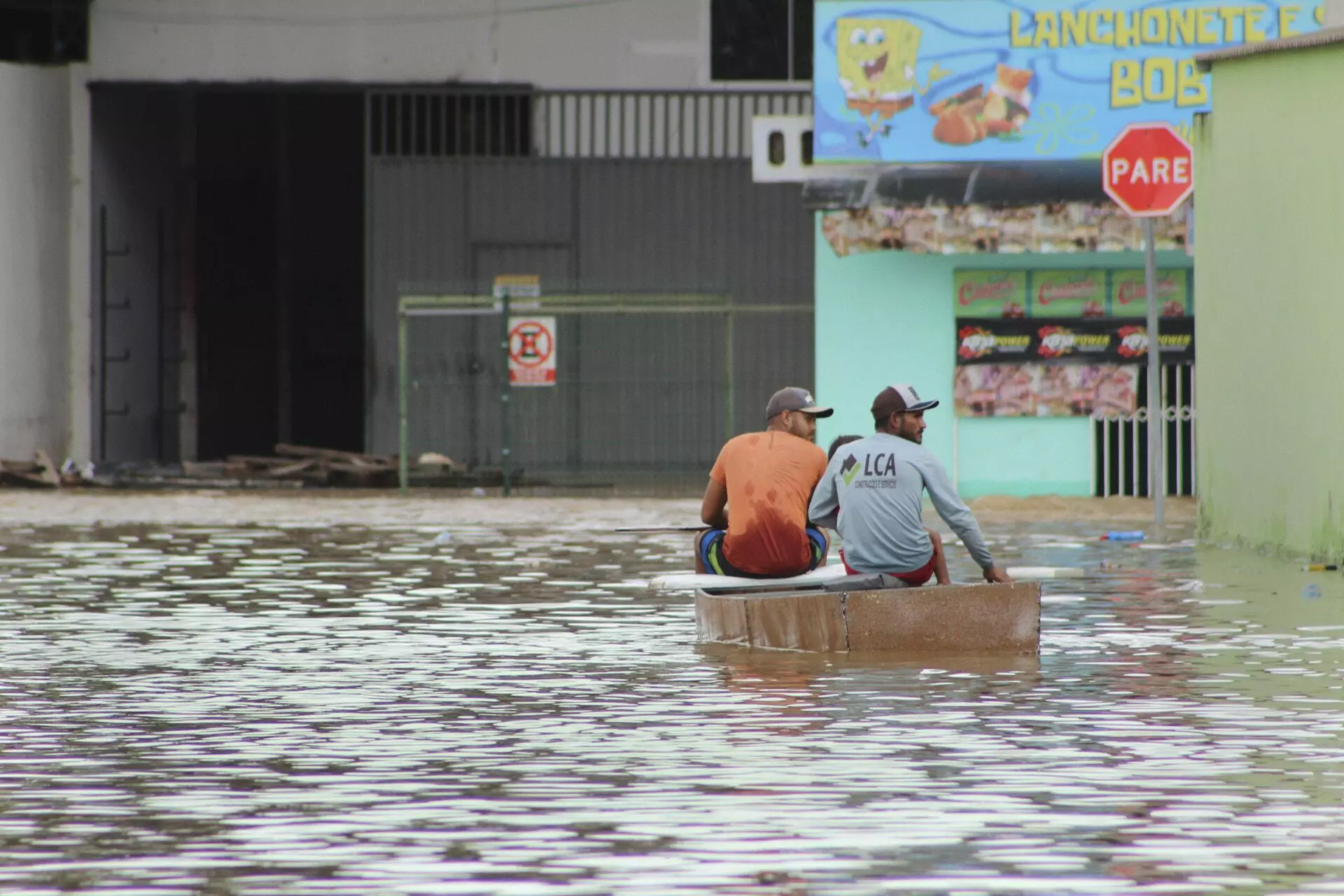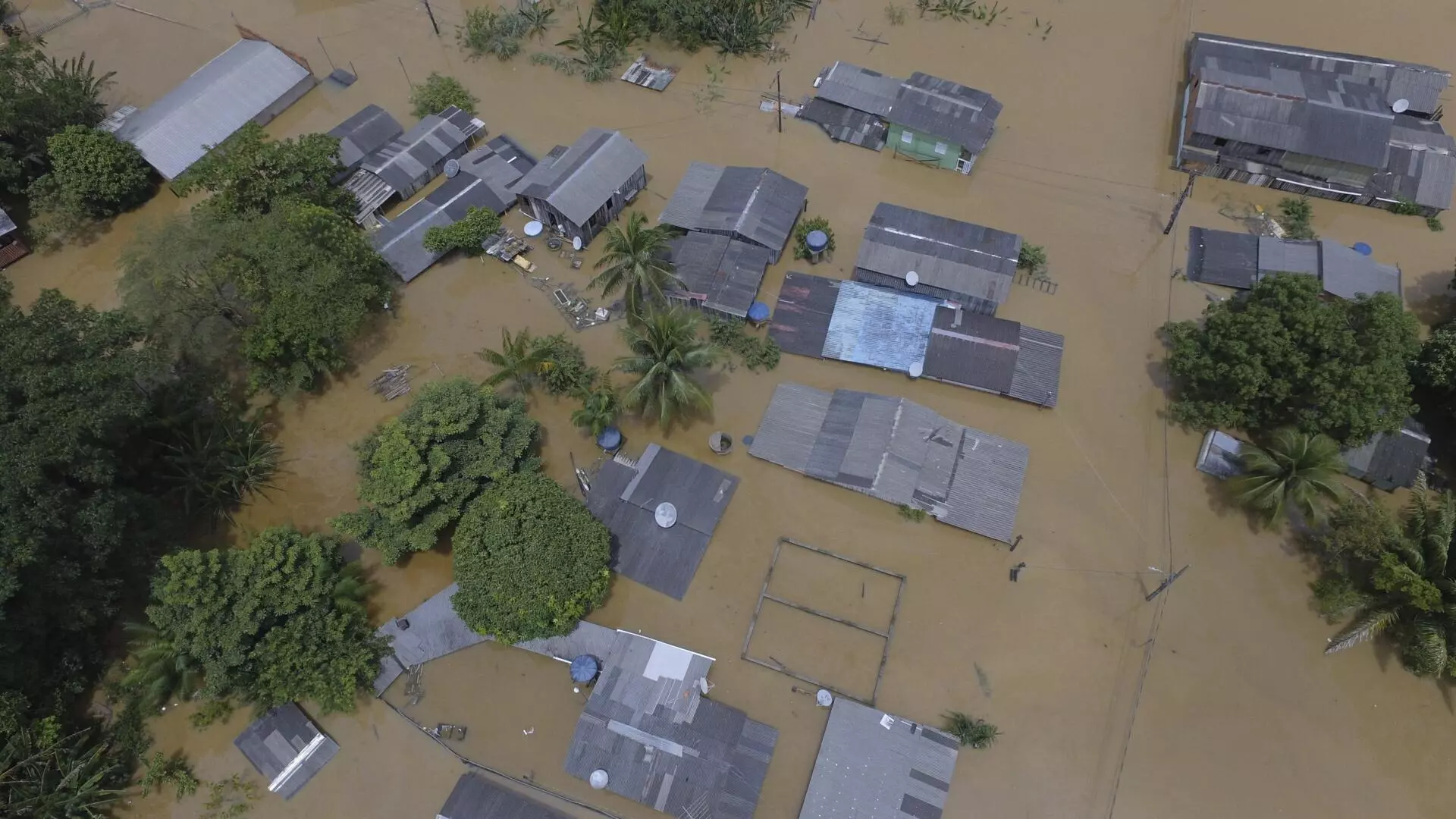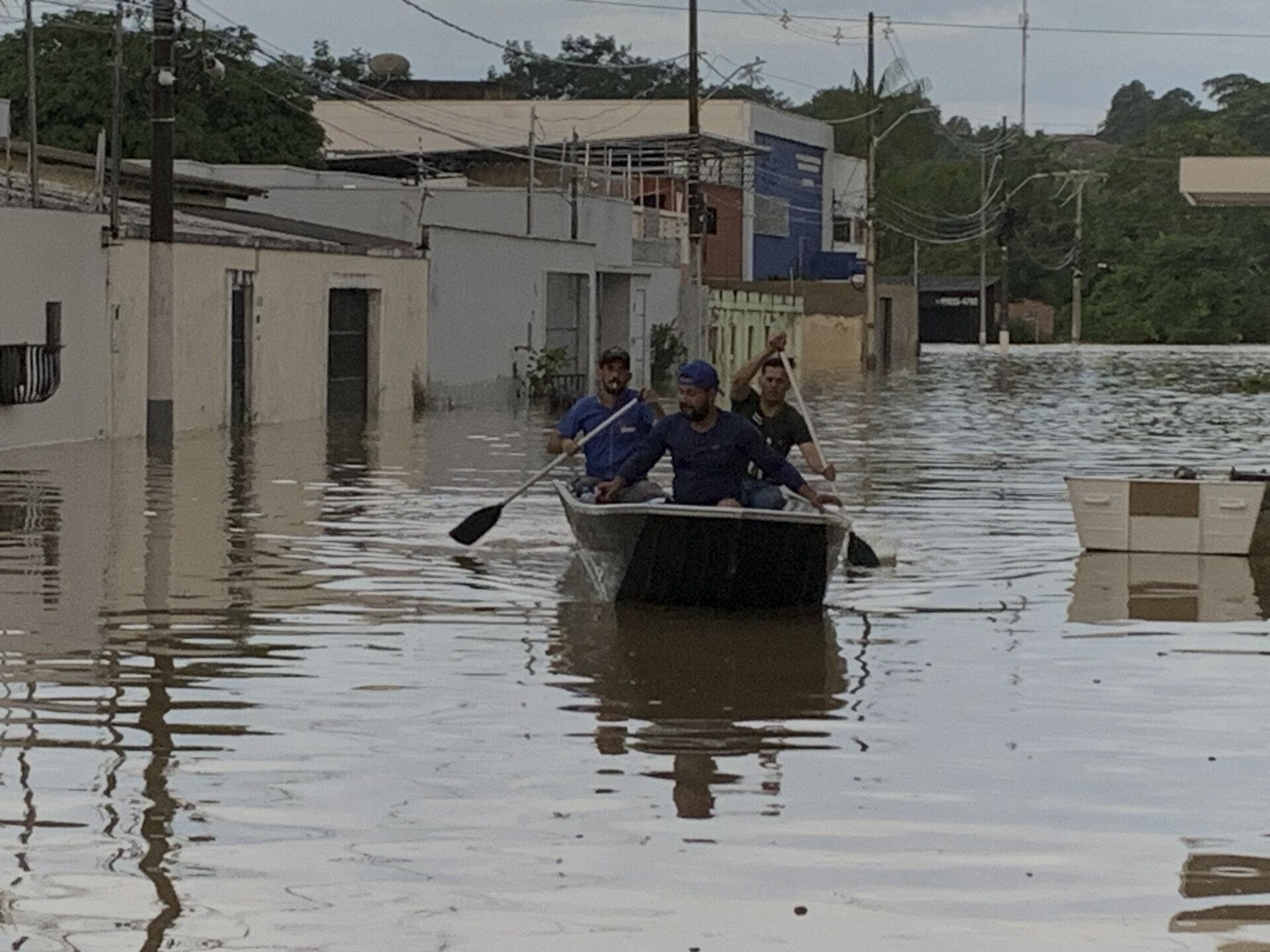When the São Francisco River overflowed on the night of March 23, 2023, in Rio Branco, capital of the state of Acre, it could easily have been just another story for this reporter from the Amazon, who often writes about the flooding that occurs during what we call our winter. But as the waters washed farther up my street, inundating house after house, I realized there was no way I could write about this flood as if it were simply one more story in my life as a journalist. At that point, I was on the other side of the facts; I was the news, a further statistic, one among thousands of flood victims.
When the river that lies half a mile from my home breached its banks, I wasn’t worried about reporting on the flood, because all my attention was focused on protecting my furniture and appliances from the muddy waters as they gushed into every room of the house. A vain struggle: once the waters make their way in, there is no going back. I felt completely impotent, hopeless—and incredulous.
I was born and raised in Vila Ivonete, a middle-class neighborhood in the capital of Acre. In my 36 years on the São Francisco River, its waters have never approached my house, let alone threatened to come in. We had a flood in February 2021, but the water stayed dozens of feet from my door. Prior to that, there had been a flood in 2004, so there was a long gap between the two events. This time, flooding recurred in just two years, from 2021 to 2023. And now the force of the water was even greater.
For a journalist from the state of Amazonas who has followed extreme weather events like floods and droughts since 2006, it had never crossed my mind that my own home might fall victim to floodwaters. I’ve lost track of how many times I’ve set foot in the waters of the Acre River and travelled by canoe to report on the tragic stories of people impacted by flooding. Now, in my own home, I found my feet, legs, and belly under water.
March 23: a furious river
It was Thursday, March 23, 2023. After a tough work week, I was enjoying a beer and listening to some music. All day long, local news sources had been predicting rivers would spill over their banks. This is often the case here in this Amazon city, beset by poor infrastructure.
Shortly before, torrential rains had pummeled Rio Branco for twelve hours straight. According to the local emergency management agency, seven inches had fallen by noon on Thursday. The Acre River rose quickly, backing up its tributaries and worsening the situation. To have an idea of the volume of water: by night, the river had climbed from 32 to 48 feet (9.76m to 14.65m). Never in the history of Acre had the river risen 16 feet (5m) in a single day. In 2015, the river had crested at 60 feet (18.4m); in 1997, at 58 feet (17.72m). The flood of 2023 was the third heaviest in fifty years.
In this southern region of the Amazon rainforest, March rains signal the end of our so-called winter—unlike southeastern Brazil, where, as Tom Jobim sings in “Waters of March,” the month’s rains announce the end of summer. Here in the Amazon our lives are governed by two cycles: the rainy Amazonian winter, running from October to March, and the region’s drier summer, from April to September, when forest fires burn strongest. With each passing year, these climate events grow more extreme.
It was after 6:30 that evening when I noticed unusual traffic out front. Getúlio Vargas, the main thoroughfare in my neighborhood, had become impassable, and drivers were looking for an alternative route. That’s when I realized the river had breached its banks. I put on my sandals and went to check things out. By then, nothing but buses and trucks could get through; just hours later, only canoes, motorboats, and jet-skis were able to traverse the streets. Trudging through shin-high waters, residents labored to save whatever they could: televisions, clothing stuffed into bulging suitcases, cars, and pets.
I waded through the water towards the river itself and the region where flooding was more serious. Residents and business people were frantic. Drugstores, butcher shops, repair shops, clinics, restaurants—everything was under water.
I went back to our house to monitor the surging waters, still not too worried. After all, in my nearly forty years here, the river had never reached us. But my detachment eventually gave way to concern as the waters crept closer to my doorstep. When I opened the bathroom door, I saw water backing up through the drain. Soon dark waters encroached on our yard. We hastened to minimize damage while struggling to maintain our cool and determine priorities.
The water invaded fast and furious. Suddenly, there were no more dry rooms, and our white floor turned into a pond of murky water. My mother, sister, and I were at home then. We were trying to salvage some of our furniture when the power went out, leaving us in the dark except for a bit of light from an emergency lantern. Without electricity, our situation grew more desperate.
We lugged our entertainment center out of the living room and perched it on top of some kitchen chairs. Our efforts were futile, however, since the water reached almost everything a few minutes later. Couches and beds were floating; we rushed to get the dogs out of the backyard. I phoned my other sister, who lives in a part of the city unaffected by the flooding. Her mission was to help us rescue the animals and bring us some bricks to prop up beds and couches in a final attempt to mitigate the damage. We asked a crew of firefighters for assistance, but by then it was too late: the dirty water, contaminated with sewage, was already over three feet deep.
With nothing more to do, my mother went to my sister’s in hopes of getting some sleep—as if that were possible. I decided to stay. My adrenaline and stress levels were sky high; but I didn’t want to leave, even though I had no place or way to get comfortable.
The hammock on the porch was still dry. I hung it high enough that I could lie down without sloshing in the waters of the São Francisco, my uninvited houseguest. People who live in stilt houses on the edges of the Acre River deal with flooding the same way: their hammocks become their only dry refuge until the waters fall while people who have canoes make these their spot of dry land.
Although the authorities were appealing for people to go to public shelters, residents resisted the idea, fearing their homes would be victimized by “water rats,” the thieves who travel by canoe under cover of night to break into homes in flooded neighborhoods, stealing whatever they find in the deserted houses.
I don’t know if I was afraid of the water rats, but I resisted too. I prayed for the ropes on my suspended bed to hold. Nestled in the folds of this hammock—my partner during so many field reports—I monitored the water’s behavior. My reference was our wellhouse: I kept an eye on the level of the muddy waters against its white tiles. To my dismay, every time I pointed my flashlight in that direction, I saw the waters had risen higher.
I gave up on trying to confront the force of nature. There was nothing to do but wait, so I tried to catch a nap. The night was a bit nippy, and my soaked Bermudas made things chillier. Inches below me, the water was cold, while the heavy clouds above gave me little hope the water level would drop anytime soon. I prayed it wouldn’t rain the next day.
March 24: waiting for the river to crest
As day broke, the natural light revealed the dimensions of the disaster. Every house on the street had been flooded, except those on the high end. I stand five feet, eight and a half inches tall (1.74m), and the water was above my waist. The wellhouse that had served as a yardstick was completely under water.
My father had shown up in the middle of the night to help. He talked me into going to my sister’s house to shower and have some breakfast. I like to walk around barefoot, and my rubber sandals had been swept away in the flood. I tried to take as much as possible with me. I had to tread carefully, sliding my feet along so I wouldn’t get hurt on the sticks and small creatures carried in by the waters. Flooding often brings in snakes and caimans. Fortunately, no new animals were around, just a lot of rubble.
Here and there, I came across submerged bricks and even pieces of furniture, which I would drag over to the nearest wall. I pulled fans out of the water, their blades and motors intact. At my mother’s request, we loaded garbage bags with clothes and bed linens from her closet to use at my sister’s.
My bed was floating in my room, but the nightstand holding my notebook and television was still in place, although the water was menacingly close to covering it all, much to my chagrin. I put my TV, printer, and power cords on the highest shelf and tucked my computer—main tool of my trade—safely in my backpack so I could take it to the car.
I had bought some frozen chicken the day before, so I grabbed it from the refrigerator—likewise afloat. That was the only edible food left; the filthy floodwaters had contaminated the rest. With the aid of neighbors, we laid the refrigerator on top of the table and rescued both television sets.
The river had crested, and the damage was visible. Now we would have to wait for the water to recede. In front of our house, a constant stream of canoes and motorboats, their engines off, transported people who hoped to recover furniture from their homes and offices.
I felt utterly discouraged. Water had invaded my little world, where I thought I had been safe. But now I understand no one is safe from the climate crisis, from nature’s response, regardless of color, creed, or social class.
The marks on our front gate registered the journey of the waters as they receded, and the river gradually returned to its rightful place—or were we the ones who had invaded?
March 25: starting over
It was only on Saturday morning, March 25, that the water abandoned our home. The night before, I had slept in a hammock again, this time at my sister’s. I was dry, showered, and lying more comfortably. When I returned home early that day, I opened my front gate to find the water had been replaced by mud. While I was relieved to see the river had left, my sensation of hopelessness hung on.
I recorded the damage inside. The power still wasn’t back on, and furniture was scattered all over. The washing machine and LPG gas cannister had been held in place by their hoses. My sister’s room was a total loss. The wardrobes where we hung our clothes had to be thrown out.

In February 2021, the river also flooded, but the water didn’t reach the journalist’s door. Never in the history of Acre had the river risen 16 feet (5m) in a single day like happened this year. Photo: Fábio Pontes
The damage was immeasurable. Luckily, the refrigerator still worked—one less expense. Our mattresses and couches could also be salvaged. A mountain of debris sat in front of the house, and the street was thick with people who make their living scavenging for recyclables. Bit by bit, our flooring reappeared. This was the first day of a lengthy process of recovery and rebuilding that continues today.
I’m not talking only about physical rebuilding. I now know a flood leaves marks not only on walls but also inside us. Trauma and fear persist. Whenever heavy rain begins pounding down, I go on red alert. For the next two weeks, with the Acre River still above flood level, I found it impossible to relax, fearing a new deluge would send its tributaries out of their banks once again.
The flood made me feel utterly impotent and exceedingly small. Life goes on. We’re alive and healthy enough to rebuild. The river is just over there. Mistreated and abused for years, increasingly serving as a garbage dump and sewage deposit, the river has sent us all a harsh message. We and the river will have to carry on—but I hope we can draw lessons from so many tragedies.
Spell check (Portuguese): Elvira Gago
Translation into Spanish: Meritxell Almarza
English translation: Diane Whitty
Photography editing: Marcelo Aguilar, Mariana Greif and Pablo Albarenga

For the two weeks after the tragedy, the Acre River was still above flood level. Photo taken in March, 31, by Gleilson Miranda/Fotoarena/Folhapress






